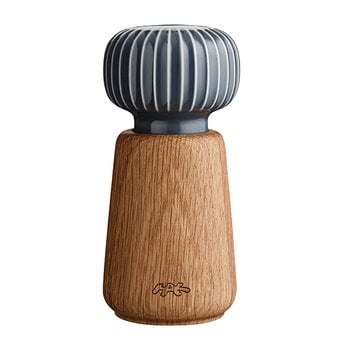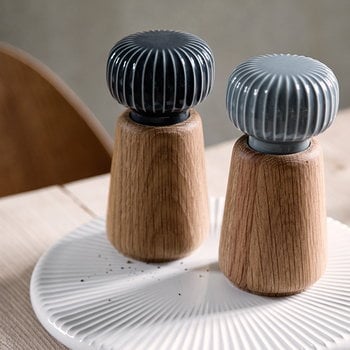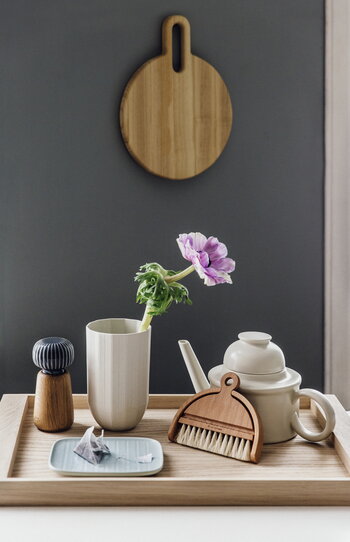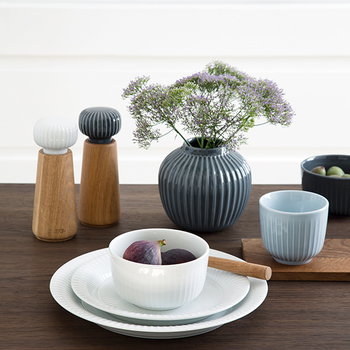Hammershøi grinder, designed by Hans-Christian Bauer for Kähler, is part of a beautiful ceramic collection named after artist and ceramicist Svend Hammershøi. He worked for Kähler from 1893 until his death, and his large vases and bowls were often adorned with simple vertical furrows. The same decorative pattern repeats in the timeless Hammershøi collection that is perfect for both everyday use and festive settings.
Hammershøi grinder, 14 cm, anthracite
Kähler
Description
Hammershøi grinder, designed by Hans-Christian Bauer for Kähler, is part of a beautiful ceramic collection named after artist and ceramicist Svend Hammershøi. He worked for Kähler from 1893 until his death, and his large vases and bowls were often adorned with simple vertical furrows. The same decorative pattern repeats in the timeless Hammershøi collection that is perfect for both everyday use and festive settings.
Product details (4)
- Material
- Oak, porcelain
- Colour
- Oak, anthracite
- Height
- 14 cm
- Diameter
- 6.5 cm
- Product ID
Designer
Hans-Christian Bauer (b. 1980) is a Norwegian industrial designer who graduated from the School of Architecture of the Royal Danish Academy of Fine Arts in 2010. Bauer works in Copenhagen as a product and furniture designer, and has collaborated with various different brands, such as Kähler, &Tradition and Menu. His best known designs include distinguishable, modern ceramics with a warm, classic touch.
View all productsReviews (2)
5
Based on 2 reviews
-
H
Heidi R
Doncaster, United Kingdom
The grinders are very stylish and attractive. Expensive but I guess if you like them enough they’re worth it
388 days ago
-
T
Tuula A
Punkalaidun, Finland
91 days ago
Sustainability
The Product Sustainability Framework, our criteria of sustainable design, helps you find the most sustainable products in our selection. Read below which sustainability criteria this product has met.
Working conditions & labour 8/9
-
Equal opportunities for all employees
-
Commitment to UN Global Compact, fair compensation for all employees
-
Corporate responsibility requirements defined and communicated for suppliers
-
Systematic work for improved inclusion and well-being in the workplace
-
Transparent supply chain
-
Suppliers' compliance to a code of conduct ensured
-
Direct suppliers audited and certified
-
Compliance to the UN Guiding Principles on Business and Human Rights ensured in the supply chain
-
Support for community involvement in the supply chain
Eco-friendly production 6/9
-
Fair and resource-wise water-use in production
-
No incineration or landfilling of returned items
-
No use of endangered species as materials
-
No direct environmental emissions or waste (excl. GHGs) from production
-
Material-efficient and ecological packaging
-
No potentially harmful chemicals used in own production
-
The sustainability of direct suppliers' production is addressed and monitored
-
Production and material sourcing that respect biodiversity, animal rights, and natural ecosystems
-
Positive impact on nature’s well-being through operations that regenerate natural ecosystems
Climate impact 5/8
-
Company's direct greenhouse gas emissions identified and commitment to reduction
-
Product's carbon impact identified and commitment to reduction
-
Guidance on energy- and eco-efficient use of the product
-
Low-carbon or compensated transportation
-
100 % renewable energy in own production and operations
-
Contribution to climate initiatives beyond the brand’s direct operations
-
Carbon footprint of the product calculated and goals set to reduce it
-
Carbon neutral or carbon negative product
Sustainable materials 3/6
-
Sustainable and long-lasting material choices
-
No harmful or hazardous substances
-
Responsible raw material sourcing and production
-
Materials suited for circularity: monomaterials, recyclable finishings, renewable or recycled contents etc.
-
Ecological materials: natural, biodegradable, recyclable or recycled contents
-
Outstanding materials in terms of innovativeness, responsibility, sustainability and circularity: local production or sourcing, 100 % recycled content, C2C-certification etc.
Circular design 4/5
-
High aesthetic quality promoting long-term use of the product
-
Technically durable product design and material choices
-
Design for enduring life-long quality
-
Design and support for product maintenance, repair and upgradability
-
Innovative circular design solutions: circular service system, resale platform, remanufacturing, collection of used products, etc.











